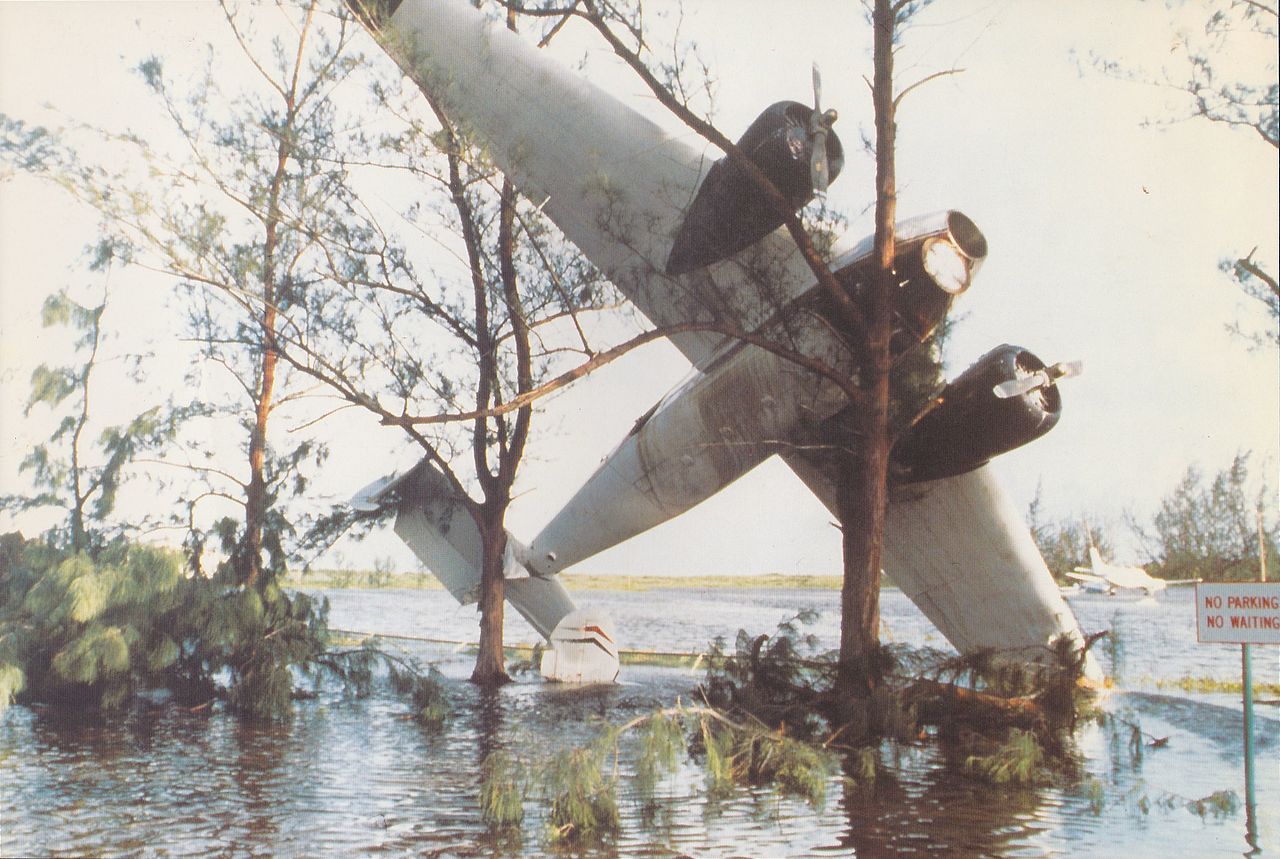1988's Hurricane Gilbert damaged 80% of homes in Jamaica and left 25% of their occupants homeless
Originally published on Global Voices

A Beechcraft 18 aircraft stuck in tree at Jamaica's airport in Kington after Hurricane Gilbert in September 1988. Photo by PvdV (CC BY-SA 3.0) via Wikimedia Commons.
Marked by “measurable rainfall […] produced by a Tropical Wave and/or the Inter-Tropical Convergence Zone (ITCZ), both of which are the main weather-producing features of Trinidad and Tobago’s wet season,” the country's meteorological office officially declared the start of the 2023 rainy season on May 26. Since that date, the twin-island republic, which is considered to lie outside of the hurricane belt—has been experiencing adverse weather, some of which has been worthy of yellow level public alerts.
The annual transatlantic hurricane season begins on June 1 and holds the Caribbean to ransom for six tense months with its threat of devastating storms—a pattern that seems to be intensifying as the climate crisis worsens. Barbados’ Meteorological Services have already taken note of the first named storm of the 2023 Atlantic Hurricane Season, Tropical Storm Arlene, which formed in the Gulf of Mexico on the afternoon of June 2.
Just the day before, Chair of Jamaica's National Disaster Risk Management Council and Prime Minister Andrew Holness addressed a meeting at which they cautioned citizens to be prepared for the upcoming hurricane season, and to guard against misinformation. But sometimes the only way a region so battered by natural disasters can face this annual phenomenon is to look back.
Jamaican Twitter user Wayne Chen marked the start of this year's hurricane season by remembering the 1986 floods that proved disastrous for that country:
2/2 and other infrastructure damaged. The impact was worst in Clarendon where the new May Pen/Rio Minho bridge collapsed killing 8 in a minibus.https://t.co/HehISdGOnG
— Wayne Chen (@wcchen) June 1, 2023
As fellow Twitter user and Global Voices author Emma Lewis responded, just two years later, Jamaica found itself in another crisis:
And in 1988 there was Hurricane Gilbert. https://t.co/6wsrHOgE0h
— Emma Lewis (@Petchary) June 2, 2023
On September 12, 1988, Hurricane Gilbert, a Category 5 storm with an eye 40 miles (64 kilometres) in diameter, killed over 200 people in Jamaica. Winds reached a speed of 175 miles per hour, knocking out electrical power and ripping metal-sheeting roofs off houses as if they were labels on tin cans. An estimated 80 percent of homes were seriously damaged, with about 25 percent of their occupants left homeless. The campus of University of the West Indies near Jamaica's capital, Kingston, was practically immobilised, and it took the country a long time to bounce back and rebuild. Damage was estimated to be as much as four billion US dollars.
Since then, storms in the Caribbean appear to have become progressively stronger. As Twitter user Ricardo Davis noted, as Jamaica faced Hurricane Matthew in 2016:
#HurricaneMatthew *presently* is #stronger than #HurricaneGilbert when it hit #Jamaica.
— Ricardo Davis
(@ricardo_1021) October 1, 2016
Still, Gilbert remains one of the strongest hurricanes on record. Jamaican blogger Susan Goffe recalled the experience in a 2016 post:
I remember the first tree to fall in our garden, the massive guinep tree that was completely uprooted very early in the storm […] I remember letting the dogs out during the eye of the storm, and walking around in the garden, seeing the damage already done. It was quite still and the sky was blue. And then the incredible intensity of the winds when they returned, from the opposite direction. By nightfall, the sustained winds had passed, but every so often there was a strong gust and I remember lying in bed, unable to sleep, with a terrible headache, worrying about how some family members had fared.
She posted a photo of the house next door “with much of its roof gone,” saying:
The massive metal beams that held that roof had been bent back like plasticine, a mental image that forever represents for me the power of the winds during the hurricane.
Some Jamaicans, like branding strategist and former journalist Hume Johnson, believe the country would benefit from deeper examination of what she calls “a watershed moment”:
We need some good restrospective #journalism around #HurricaneGilbert, this watershed moment in our history. Who want to take on this project – a documentary- get funding for it. It would be such a treasure and a learning tool and policy instrument. #Jamaica
— HumeReports (@DrHumeJohnson) September 14, 2018
In a sense, that deeper consideration is what all Small Island Developing States (SIDS) have been asking for at the last few climate change conferences, where regional activists have called the crisis an “existential threat.” Most recently, at 2022's COP27 in Egypt, the Loss and Damage issue, which covers the impacts of climate change that occur despite adaptation and mitigation efforts, was finally added to the agenda. But for there to be any sustainable positive impact on the Caribbean stronger measures are required.
The effects of the 2023 hurricane season—which experts predict will have a 40 percent chance of being near-normal, and a 30 percent possibility of either being above- or below-normal—will help inform whether action is taken as COP28's Global Stocktake continues.
Thus far, however, the wealthy nations that contribute the most to global greenhouse gas emissions have failed to deliver on the 100 billion US dollar climate finance pledge they made in Copenhagen nearly 14 years ago.
Post a Comment